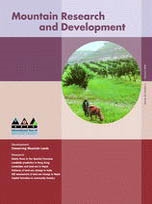A public forum for Central Asian mountain issues
To offer a place where Central Asian people can meet, exchange ideas about mountain development, and obtain and disseminate information throughout the International Year of Mountains (IYM2002), a Dom Gor or “House of Mountains” has been established in Bishkek, Kyrgyzstan. The project was launched on the initiative of the Central Asian Mountain Partnership (CAMP) Program and is being implemented with financial support from the Swiss Agency for Development and Cooperation (SDC).
The purpose of Dom Gor is to raise awareness of the realities of life in the mountains of Central Asia and to initiate dialog on sustainable development from the regional perspective of mountainous areas in 3 neighboring countries: Kyrgyzstan, Kazakhstan, and Tajikistan. Dom Gor will serve as a platform for exchange of expertise and development of innovative ideas. One of the key aims is to involve stakeholders at all levels in discussions about mountain development. A platform where local people can speak out also offers the media an excellent opportunity to take account of the perceptions of local people. This will be of particular importance in leading up to the Bishkek IYM Global Mountain Summit planned for October 2002.
A range of monthly programs
Dom Gor will focus on a different topic every month for 14 months. When it opened its doors in November 2001, the first topic was people's wishes. Wishes for IYM2002 were collected in the 3 countries and then transmitted to Bishkek. This activity enabled initial contact to be established with local people and allowed expectations to be communicated. In December mountain products, their marketing, and the creation of new income opportunities were the main discussion topics. Energy supply in mountain regions, one of the most critical issues for the future development of the region, was scheduled for January, whereas in February, discussions will focus on innovations for a better life in mountain regions. In that month, Dom Gor will be a platform for presenting, supporting, and capitalizing on recent innovations.
In March, discussions will be devoted to communication and conflicts over natural resources. Discussions as well as an interactive theater will offer an opportunity to participate in workshops on conflict management. In April, protection of nature is on the agenda. Discussions and events outside Dom Gor will raise awareness of nature protection and the need to focus not only on single species but also on conservation of habitats and entire landscapes, as is possible when creating biosphere reserves. Tourism can provide additional income for mountain regions, but it also has impacts on society and the environment. Discussions in May will illustrate different types of tourism development as well as ways of managing adverse impacts. In June, the focus will be on water, also a very critical issue in regional development. Also related to water is the topic of climate change, which will be discussed in July.
In September 2002, Dom Gor will be open to mountain villages building their future. It will host an “alternative conference,” the aim of which is to found a network of villages to discuss methods of sustainable village development and regional sustainable development in Central Asia and to supply inputs for the Global Mountain Summit. In October, when the official IYM2002 mountain summit takes place, the topic of land use in the Tien Shan and Pamir regions will provide additional information for the media. In November, the last of the topics will emphasize Central Asian households and their livelihood strategies. The use of high pastures will be discussed in particular. In December 2002, Dom Gor will close its doors, but only after drawing conclusions about the events that will have taken place throughout the year, in order to build a basis for future activities in the region.
Circulation of information
An internal publication, the Dom Gor Newsletter, presents news and events, details of the next month's agenda, and questions related to mountain development issues. The newsletter is published on a monthly basis and printed in both English and Russian. It is distributed at the end of each month in Central Asian universities, public libraries, hotels, and restaurants. An online issue of the Newsletter is available on the Dom Gor Web site, with the possibility of subscribing by sending an email request to domgora@camp.elcat.kg.
One month before Dom Gor was inaugurated, the wishes of the Central Asian population regarding mountain development were collected in over 30 locations in Kazakhstan, Kyrgyzstan, and Tajikistan near symbolic “trees of wishes” such as this one in Bishkek. The Bishkek Tree of Wishes was inaugurated in a well-attended public ceremony, with the participation of a local theater group, the town authorities (represented here by Aitmurzaev Nurlan Tashmurzayevich, of the Bishkek Mayor's Office), and CAMP/Dom Gor personnel. (Photo by CAMP, November 2001)






